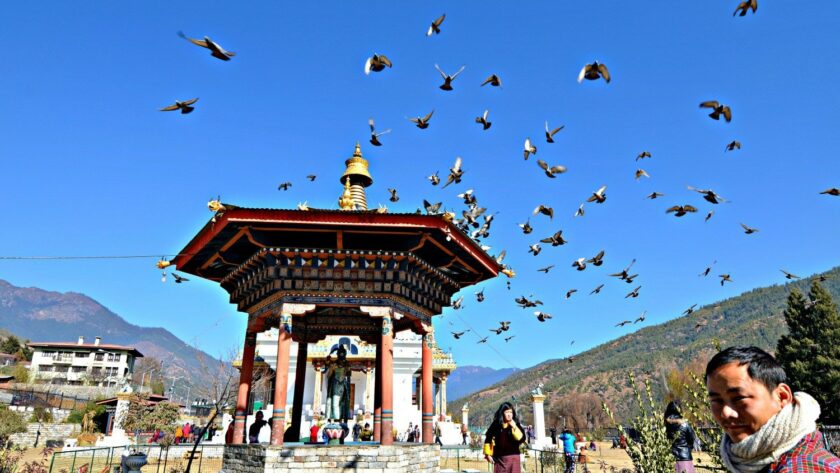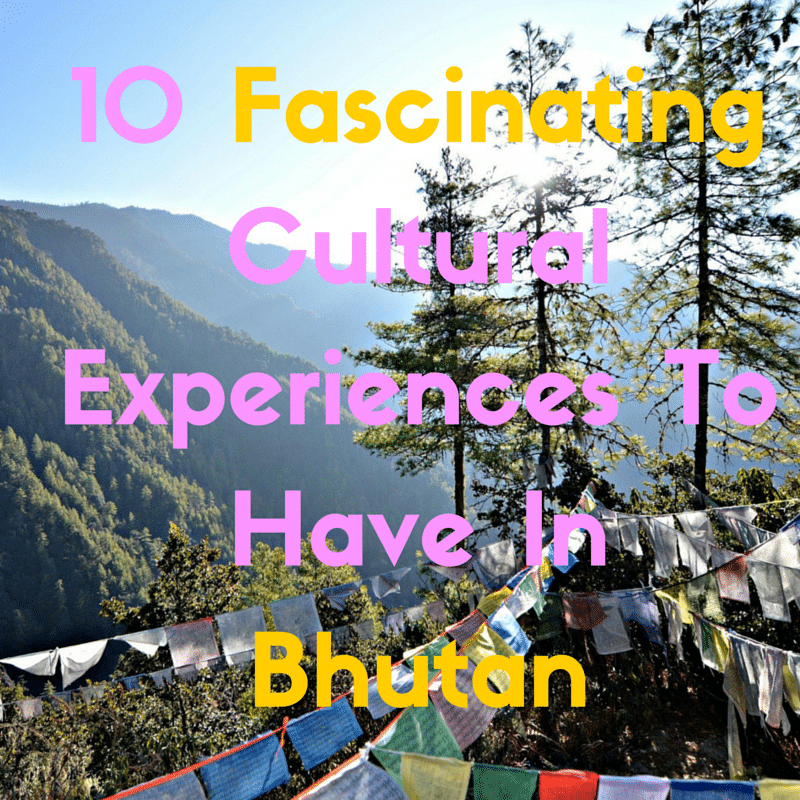Bhutan culture. It’s one of the biggest reasons to visit the country in the first place, as the main draw for many is the well-preserved heritage (as well as the mountain and valley landscapes). With the help of my Bhutan Tourister guide, Kinley, I enjoyed a number of immersive travel experiences to truly get the most out of this amazing destination, like:
1. Learn The Art Of Traditional Crafts At The Gagyel Lhundrup Weaving Centre
Bhutan places a high importance on preserving the country’s traditions. In fact, it’s one of the four pillars of the country’s Gross National Happiness Index. With this index, the country’s economic success is not based on wealth, but on preservation of the environment (their Constitution mandates Bhutan be at least 60% forest), good governance, sustainable socio-economic development and cultural preservation.
At the Gagyel Lhundrup Weaving Centre we enter a small room with a low ceiling full of local women working with backstrap looms to weave colorful handmade garments. Kinley explains that most weavers come from the eastern part of Bhutan where it’s a tradition, and that some garments, especially those of pure silk, can take around 6-to-7 months to create. After we peruse the upstairs showroom — you can also learn more about local garments in the National Textile Museum in Thimphu — we head into the art gallery next door, where 15-20 local artists showcase paintings mainly depicting Bhutan culture and Buddhist scenes.
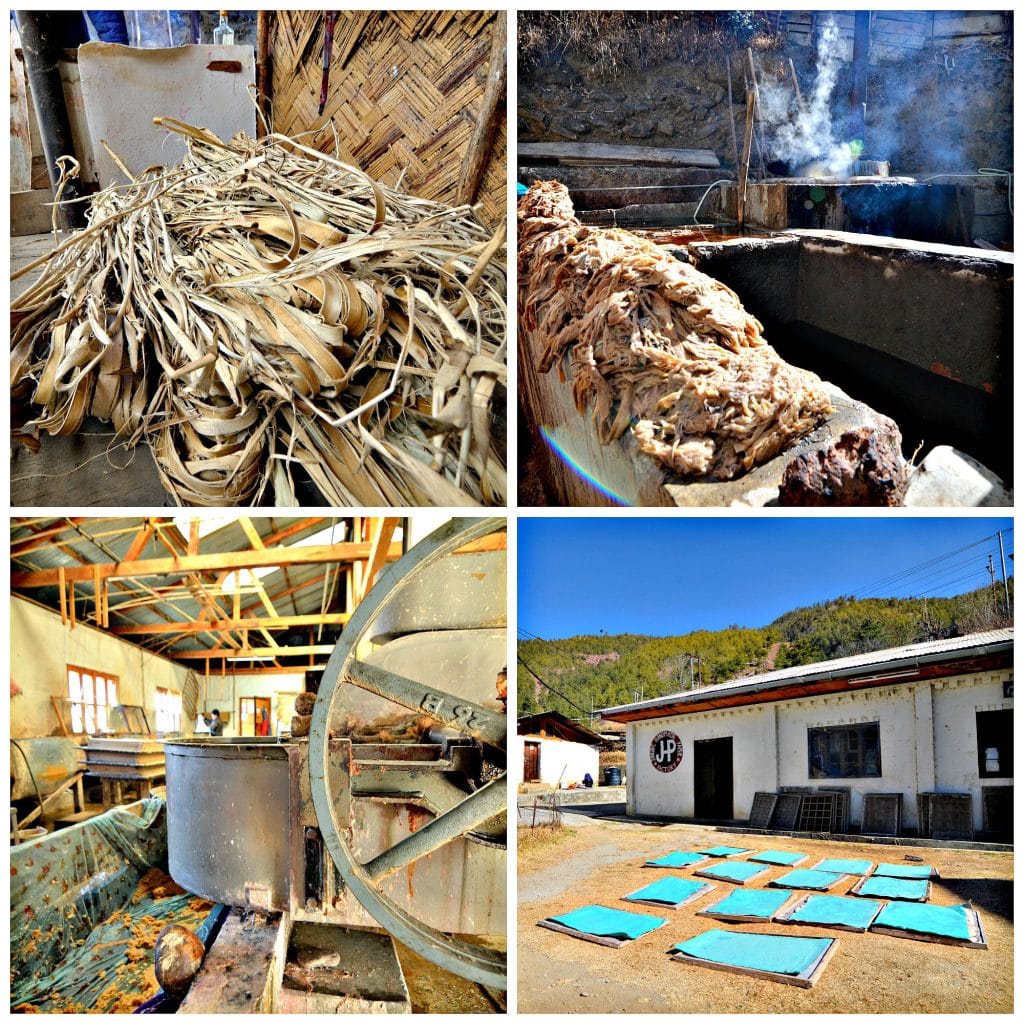
2. Purchase Traditionally-Made Paper Products At The Jungshi Paper Factory
Handmade paper is an important tradition in Bhutan, originally crafted for the writing of mantras and prayers at temples. At the Jungshi Paper Factory, traditional techniques have been employed to turn high altitude Daphne and Dhekap trees into high-quality paper products since 1990. A short walk through the small but able factory takes me on the tree bark’s journey, beginning with it being soaked for 24 hours, boiled and washed, spun and mashed into a pulp, mixed with starch, and molded using a bamboo net. The wet sheets of fresh paper are pressed to remove excess liquid, and dried either by steam or laid out in the sun.
Onsite, a small gallery sells handmade cards, wall hangings, notebooks and other paper goods for about $2.25+. I leave with a thick paper envelope full of dragon prints — so much better than a Made In China keychain, by the way).

3. Immerse Yourself In “The Good Ole’ Days” Of Bhutan
While as a Westerner it definitely seemed like Bhutan was still enjoying the good ole’ days — they only got their own currency in 1974 and TV and internet in 1999 — the truth is outside of the smaller villages the younger generations are starting to become addicted to their Apple gadgets like the rest of us. In order to preserve the traditions of Bhutan for the country’s youth as well as for visitors to see, the Folk Heritage Museum was established. Now, I’m not typically a museum person, but this educational venue was of the immersive variety. You’ll actually walk through a three-story 19th-century house set up in the traditional manner, with authentic artifacts like a 150+ year-old water mill, bamboo mats for drying grains, a stone grinder for turning beans into flour and an incense-burning hearth bringing it all to life.
Another option is a homestay experience. I did one at a farmhouse in Paro, and while I’ll be honest and say it was a “low” on my list of trip highs and lows, I think if you go over what exactly you want to get out of the experience beforehand with your guide it could be very worthwhile. I would recommend getting a schedule put together — such as at 10am you will help with milking the cows, and at 11am you will assist in collecting chicken eggs — in case you’re unable to fully communicate your desires due to language barriers.
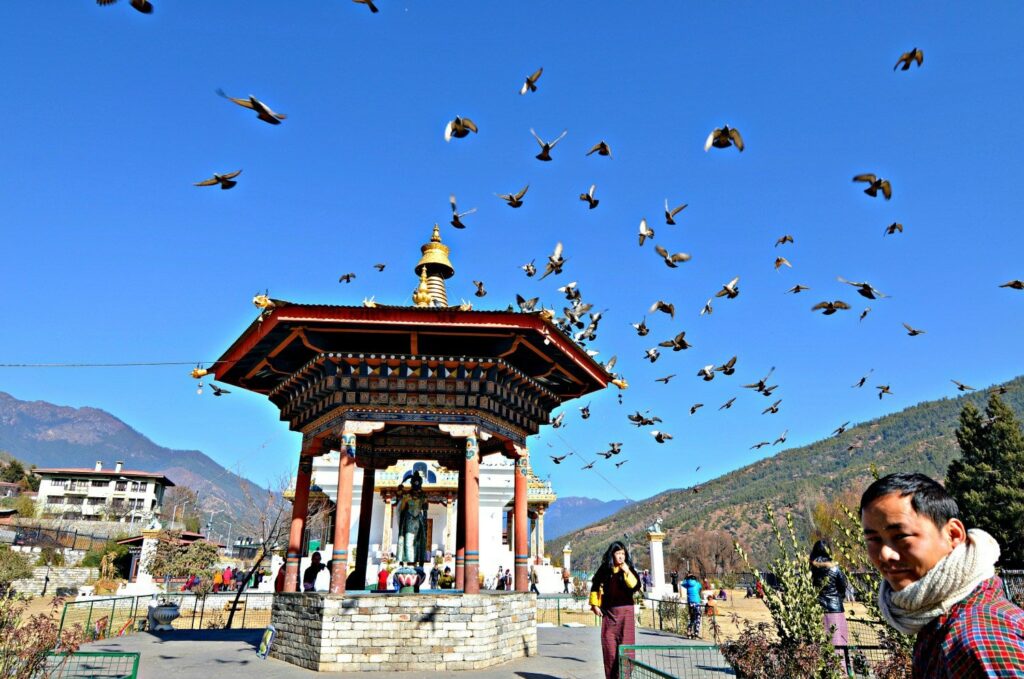
4. Have A Spiritual Stroll Around The National Memorial Chorten
The National Memorial Chorten was one of my favorite spots in Thimphu. As soon as you walk in you’ll see myriad pigeons flying in unison; a sight that would normally make me vomit in my mouth in NYC but seemed otherworldly at this spiritual spot.
Around the ornate Tibetan-style stupa with its giant gold spire top, locals walk clockwise to mimic the course of the sun and stir out their negative energies (which is why you’ll also see people rubbing prayer beads with their left hands and chanting mantras). According to Kinley, Buddhists believe that if you divide the body in half your left side has the positive energy, which gets pulled through the heart, while the negative energies get pushed out through your right. These rituals help with this.
Something unusual about this stupa is there’s a temple inside, where you can make offerings to the deities and learn about the three poisons we are all born with — ignorance, greed and hatred — which we should attempt to rid ourselves of to reach enlightenment and possibly Nirvana, a place void of suffering. Whether you’re Buddhist or not, it’s not a bad life goal.

5. Discover Why The Phallus Is So Important To Locals At The Temple Of The Divine Madman
While the drive from Thimphu to Punakha is full of spiritual and culture experiences, the one that most captures my attention is Chimi Lhakhang, or the Temple of the Divine Madman. Sure, the Punakha Dzong may be grand, but does it have a surrounding village featuring houses covered from bottom to top with penis paintings and wooden phalluses?
These do have a spiritual meaning. The Divine Madman was called so due to his unusual ways of teaching Buddhist lessons, from peeing on spiritual items and having the urine turn to gold to impregnating a nun to bring her good energy. Despite his affinity for booze, feasting and sex, the Divine Madman always had good intentions in his heart — and penis. His phallus actually had the power to grow and defeat demons, and his temple sits on top of where one such demon is buried. As the demon had turned herself into a dog before the Divine Madman defeated it, the name of the temple actually means “dead dog.”

6. See The 108 Stupas At The Dochula Pass
It’s here, along the East-West Highway at 10,007 feet, where you’ll find 108 beautiful white stupas known as the Druk Wangyal Chortens. The project was commissioned by the Queen Mother, Her Majesty Ashi Dorji Wangmo Wangchuk in honor of Bhutan’s victory against separatist rebels in India’s north-eastern Assam state in 2003. Along with the intense spirituality of the Dochula Pass, which also has a temple, a major draw is the panoramic views of the Eastern Himalayas which, on a clear day, are gorgeous with their white-capped peaks. Across the street is also a cafe with huge windows for sipping a hot coffee, warming your hands by the fire and enjoying the vistas.

7. Visit Where Buddhism Began In Bhutan
Bhutan is truly a Buddhist Kingdom, and it’s impossible not to go 10 feet without stumbling upon some kind of temple, shrine or stupa. In Bumthang, you can visit the Kurji Lhakhang (temple) where Buddhism began. According to Kinley, in the 8th century a demon known as Shelging Karpo took the soul of the king at the time, King Sindhu Raja. Padmasambhava (the Second Buddha) came all the way from India to help resolve the situation, though upon hearing this the demon turned himself into a white lion and hid inside a cave in the temple, which you can still see today inside the altar of the temple’s lower section. Padmasambhava was no fool though, and subdued the demon, turning him into a Buddhist practitioner that is now the deity of Jakar, protecting the land. This is how Buddhism in Bhutan is believed to have begun.

8. Hike The Tiger’s Nest
If you do one thing in Bhutan make it this experience, which was hand’s down my ultimate trip highlight. The Tiger’s Nest, an aerial temple crafted straight into the mountain rock, was founded in the 8th century, though wasn’t built until the late 17th century by the fourth ruler of Bhutan, Gyalse Tenzin Rabgye. It was built into the rock because this is where Padmasambhava subdued a demon named Belgye Singye.
During the hike you’ll walk two scenic hours uphill, so mentally prepare yourself and realize the journey is beautiful and the reward is even greater. Expect numerous lookouts with bird’s eye views of villages and woodland, as well as stops with inspiring prayer flags and wheels. While there are no cameras allowed inside the Tiger’s Nest Monastery the site is so moving and beautiful it will stay imprinted in your mind, from the altar topped with colorful ritual cakes, golden stupa-shaped vessels and burning incense to the room alight with burning butter lamps from a stellar view of the landscape from 10,171 feet.
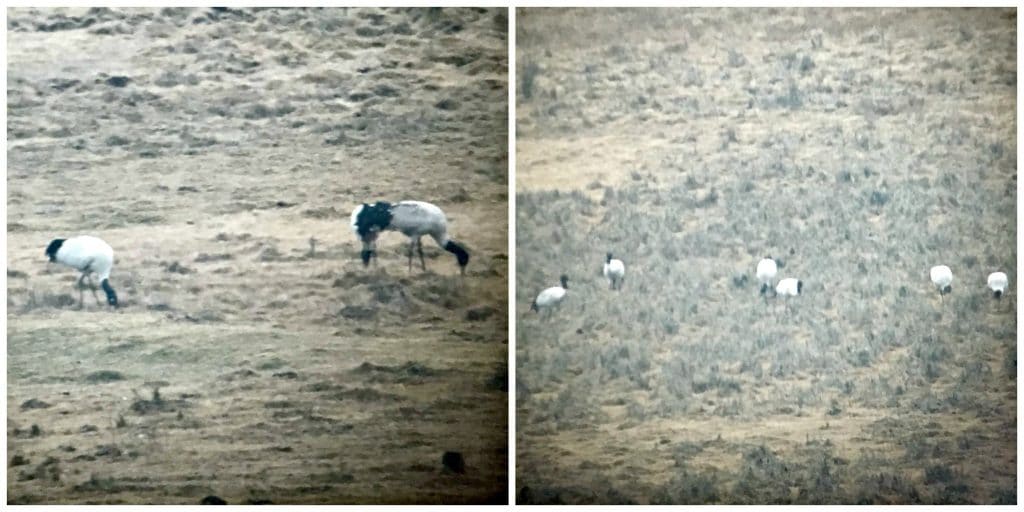
9. Visit the Valley Of The Black-necked Crane
Conservation of nature is very important to the Bhutanese. In fact, it’s one of their four pillars in the Gross National Happiness Index, not to mention it’s written into their constitution that Bhutan must be covered in a minimum of 60% forest (it’s currently covered in 72%, according to Kinley). The Valley of the Black-necked Crane, or Phobjikha, is one place to explore this passion. It’s not hard to spot them, their bright white bodies contrasting with their black heads and tails, sticking out against the light green and yellow grasses. The birds are known as “birds of heaven,” as they’re said to be attracted to holy places. In fact, both Kinley and the NGO representative at the local Black-necked Crane Visitor Center noted the birds fly clockwise three times around the local temple — a Buddhist practice that helps rid the body of negative energy — both when they arrive in the fall and before they migrate to Tibet in the early-to-late spring. The Visitor Center is a treat, as along with learning about the bird I was able to see them up close using a telescope (see above!).
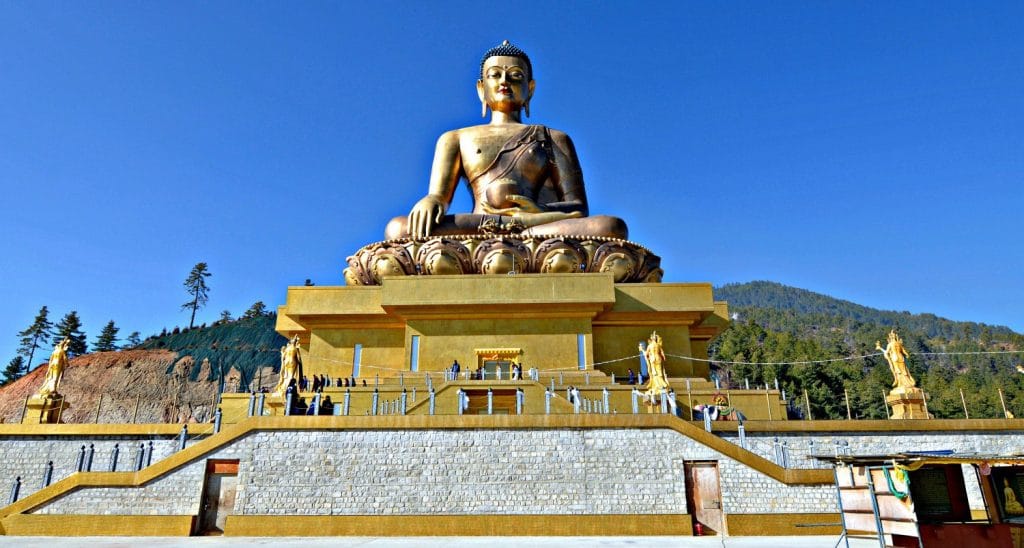
10. See One Of The World’s Largest Sitting Buddhas
At Buddha Point in Thimphu I come face-to-face — or rather face-to-pedestal — with one of the world’s largest Buddha statues, sitting grand at 169 feet tall (though if you count the gold throne pedestal the structure is over 200 feet). The placement of the seated Buddha’s fingers pointing down represents Buddha’s posture while in India when he vowed to the earth and the nagas (serpent gods believed to once own all the world’s land) that he would not get up from his meditation until he’d found enlightenment. The shining Buddha is surrounded by smaller statues of celestial beings making offerings, and inside the pedestal is a temple that, upon completion, will house over 100 Buddha statues. Tip: This is also a great spot to get aerial views of the city, as well as to cycle paths in the adjoining Kuensel Phodrang Nature Park.
What’s your ultimate Bhutan culture experience? Please share in the comments below.
Essential Info:
Recommended Tour Operator: I went with Bhutan Tourister and had an unbelievable time. I highly recommend them. Please use this booking form for inquiries.
Booking Your Trip: By law, tourists visiting Bhutan must have a guide and must pay an all-inclusive rate of $200-$250 per night (low vs high season) + airfare + $40 Bhutan visa fee (unless you’re an Indian, Bangladeshis or Maldivian national) + $30-$40 nightly tariff for duo and solo travelers. This includes your private guide, 3-star lodging, three (huge!) meals per day and ground transfers.
Responsible Tourism: Making it more difficult to visit Bhutan limits the amount of tourists entering the country, helping to preserve the landscape and traditional culture. Moreover, 35% of what you pay goes to the government to put toward free education and healthcare, infrastructure and conservation.
Health: Healthcare is free for locals and visitors in Bhutan. I didn’t encounter any hotels with gyms, so if you’re looking to stay in shape I recommend Yoga Download (900+ yoga classes right on your laptop or phone), TheraBands (inexpensive resistance bands that take up virtually no luggage space) and a FitBit wristband (encourages you to be healthy and is stylish).
Paying For Your Trip: As a points-obsessed traveler, it stung not be able to pay for the trip with my credit card. To pay for your trip you’ll need to transfer the funds in US dollars to the tourism board’s bank account. The fee for me personally through Bank of America was $45 for the transfer, though they were kind enough to waive it for me as I’m a preferred client, so that was sweet. You can easily make the transfer online if you do online banking.
Language: Dzongkha & English
Local Currency: Ngultrum (Nu). As of February 2016, 1 Nu= $0.01.
Tipping: I tipped my guide the equivalent of $10/day, as I read $8-$10/day was the norm on numerous forums and travel agency sites.
Internet: Most of the hotels I stayed at had pretty decent Wi-Fi, though there was one that said they had Wi-Fi and it didn’t work. Homestays will likely not have Wi-Fi. If you want to stay connected I recommend getting a local SIM card from TashiCell, which cost about $10 for the SIM and 10 days of credit (depending how much you’ll use it, I had lots of credit left over but I didn’t use mine much), or a KnowRoaming Global SIM Sticker to affix to your regular SIM for local rates.
Food: If you like heat, you’ll love the chili-laden Bhutanese food, though many hotels cater to tourists with more general meat and veggie dishes. I was never hungry, as portions are huge and heavy, typically featuring a heaping bowl of red rice with pasta, potatoes, fish, cheese-topped chilies, cheese-topped mushrooms, turnip flowers and other meats and veggies. That being said the food won’t be what you write home about; it’ll be the well-preserved culture and heritage as well as the beautiful mountainous, green landscapes, 72% of which are covered in forest, unlike anywhere else.
Booze/Tobacco/Weed: Bhutan is a booze-friendly country (the small capital of Thimphu has 700 bars alone), though note the country is dry on Tuesdays, which is also the day many sites and shops are closed. Despite growing plentifully weed is illegal, and tobacco is illegal to sell. You can bring your own cigarettes purchased from another country, but be prepared to pay a 200% tax on them at customs.
Plugs: The outlets varied at the hotels. In some I was able to plug a standard USA-style plug into the wall, while at others I needed the European two-prong kind. Click here for a visual. It’s recommended to get a TravelMore International Travel Adapter with USB ports so you can charge multiple devices with one gadget.
Dress: While it won’t cause an uproar if you wear a tank top and shorts, it’s a respectful gesture to keep shoulders and knees covered when not in your hotel room. This is mandatory in the local temples (as well as no hats!) which you’ll be visiting a lot of. One travel essential to carry that’s great for this is a scarf shawl — which also works as an airplane blanket!
Essential Gear: Even if you visit in the warmer months it’s essential to bring warm clothes, as the mountains can get chilly all year round. Some items I recommend:
- Smartwool socks
- Stonewear Breathe Pants
- Moisture-wicking tops
- Columbia Women’s Snow Eclipse Mid Jacket
- Classic BUFF
- BUFF hat and neck warmer set
- ExOfficio Vona Gloves
- Ahnu Montara II Waterproof Hiking Shoes
- SteriPEN (The tap water is NOT drinkable in Bhutan, though your guide and hotel should supply it. I drink a lot so I also used my SteriPEN)
- XT driFILL Women’s Goose Down Waterproof Hooded Jacket
Jessica Festa
Latest posts by Jessica Festa (see all)
- A Culturally-Immersive Adventure In Mongolia’s Altai Mountains - Jul 8, 2023
- This Recipe Sharing Platform Supports Women In The Culinary Industry (Labneh Recipe Included!) - Nov 5, 2020
- Hiking The Mohare Danda Community Eco-Trek In Nepal - Jun 3, 2020
- 6 Important Questions For Choosing A Responsible Yoga Retreat - May 18, 2020
- How To Create & Grow A Profitable Blogging Business (Ethically) - Jan 18, 2020

